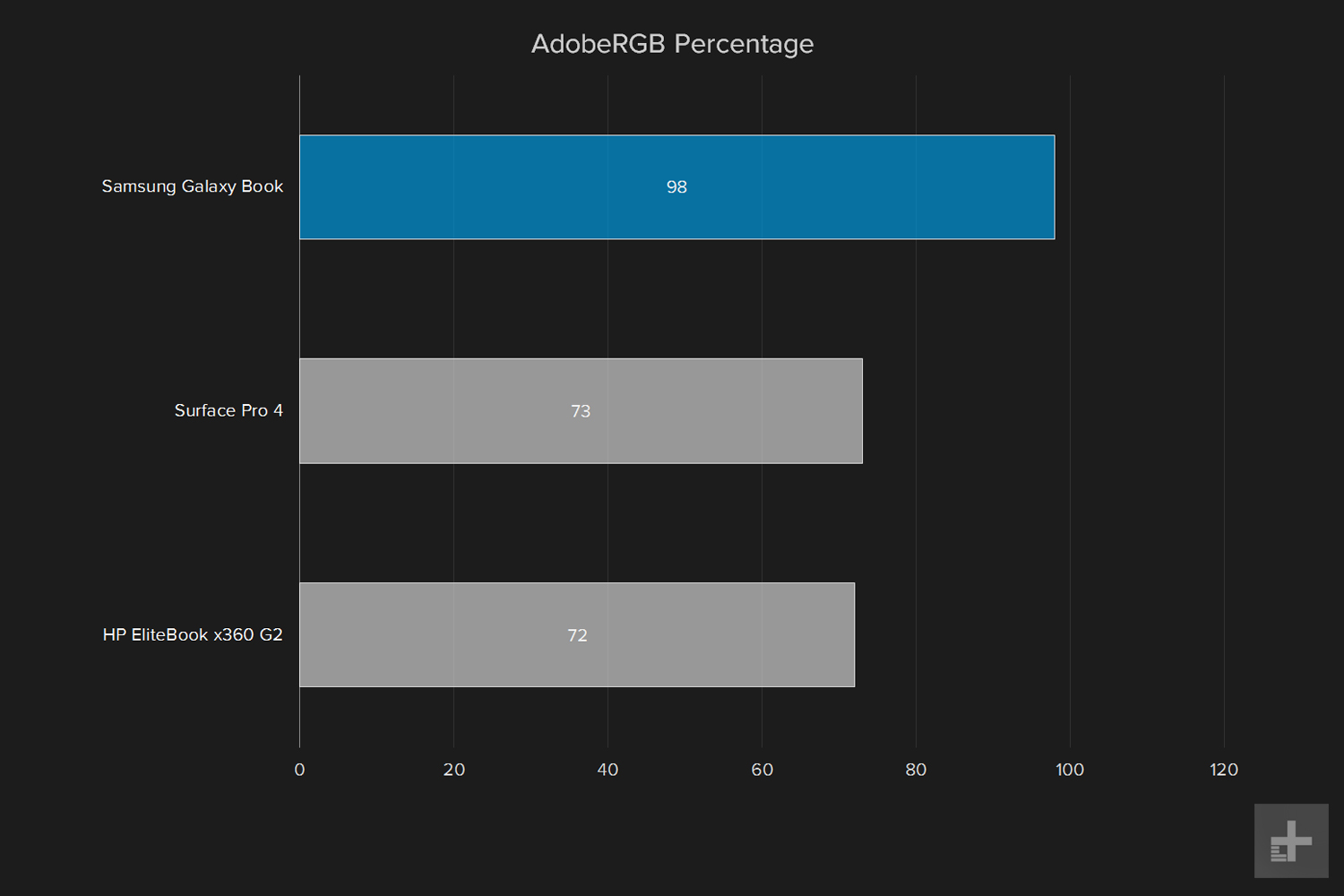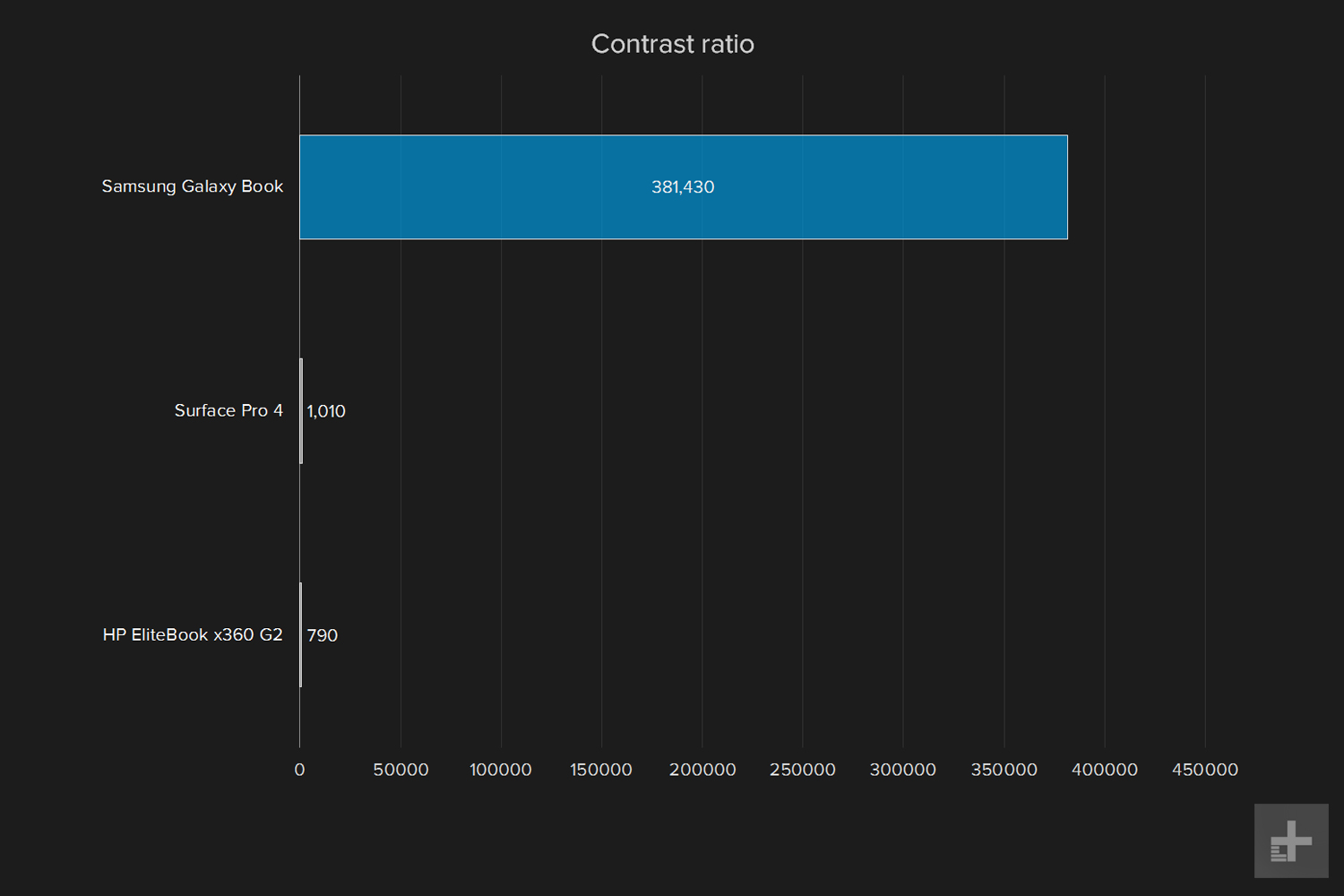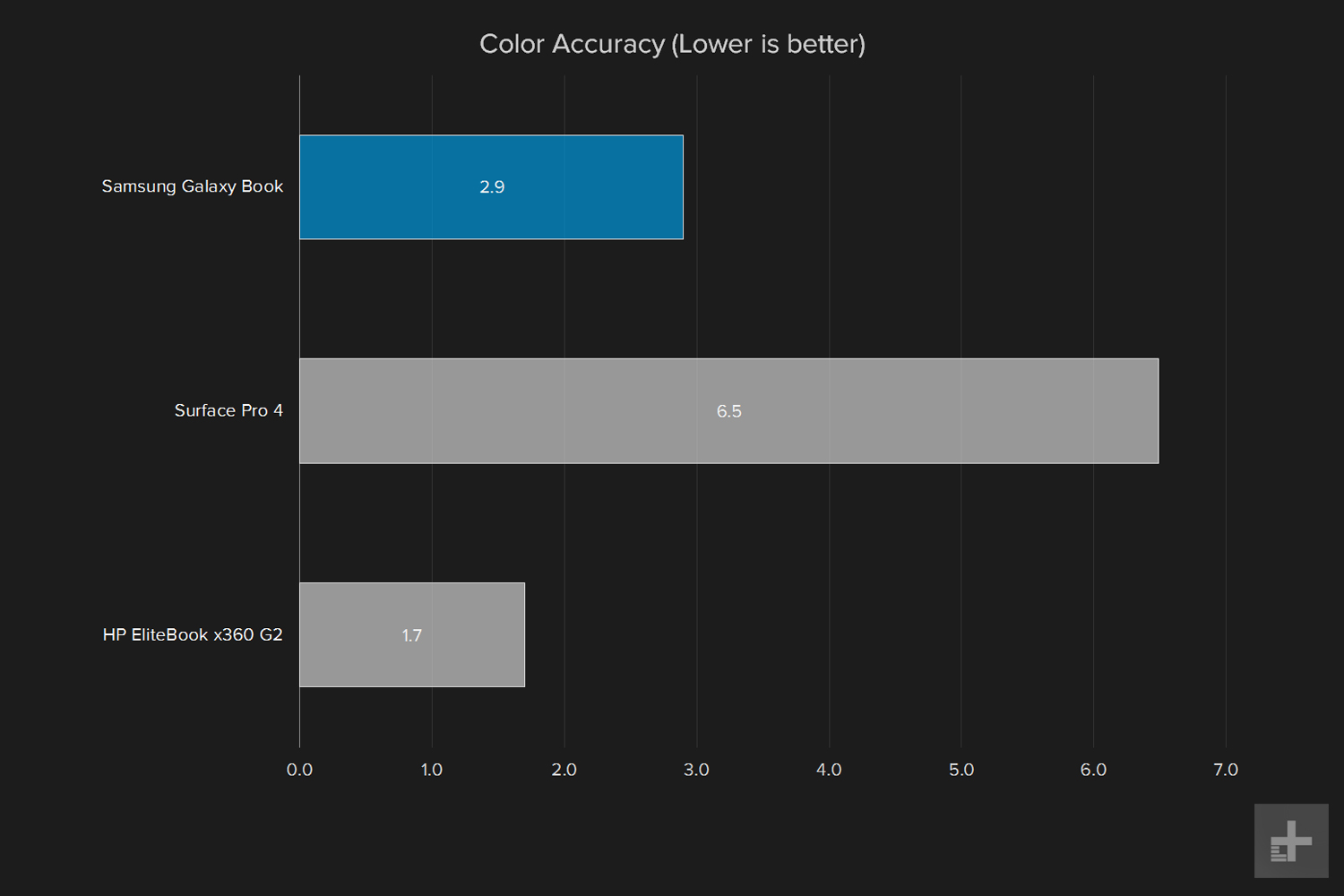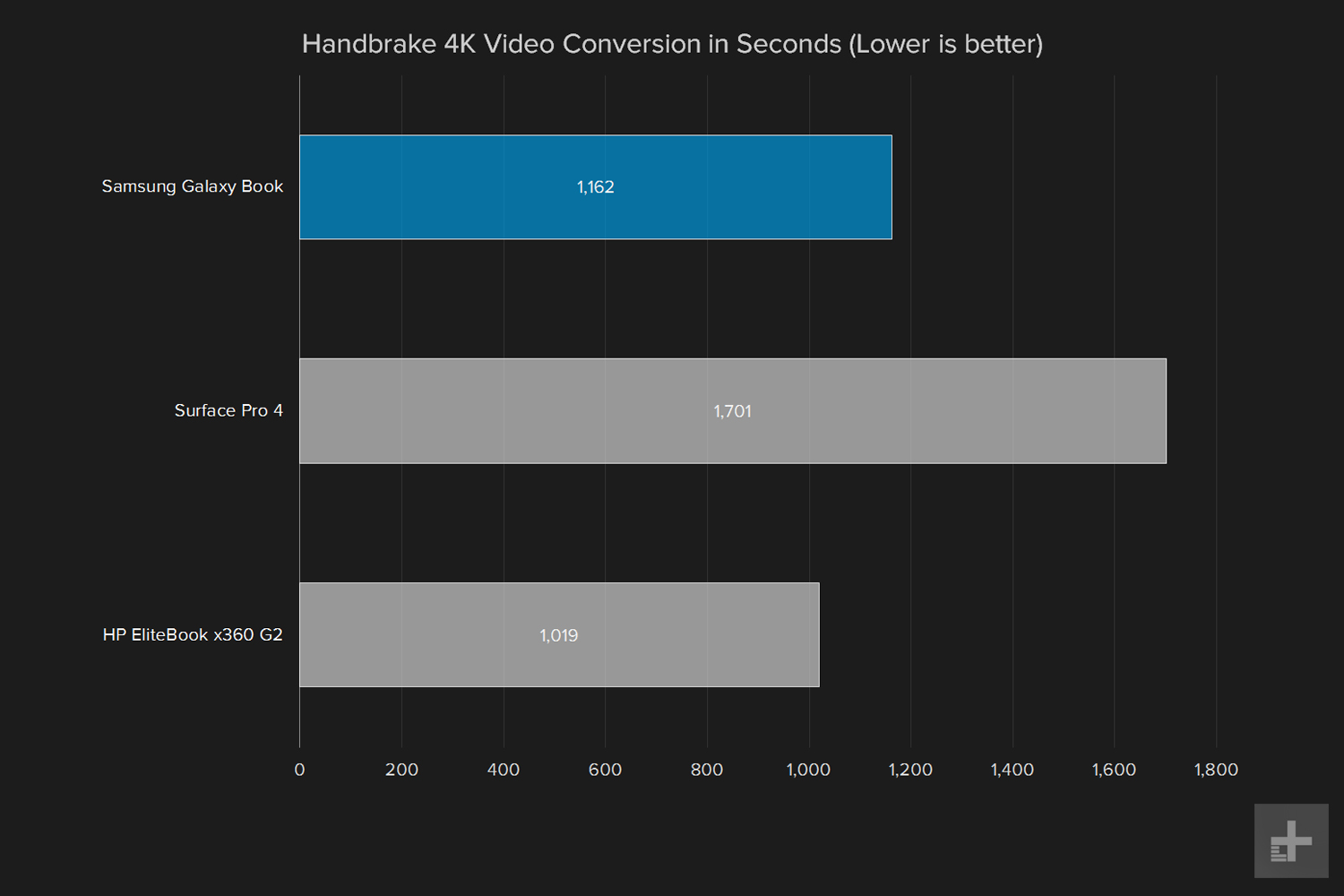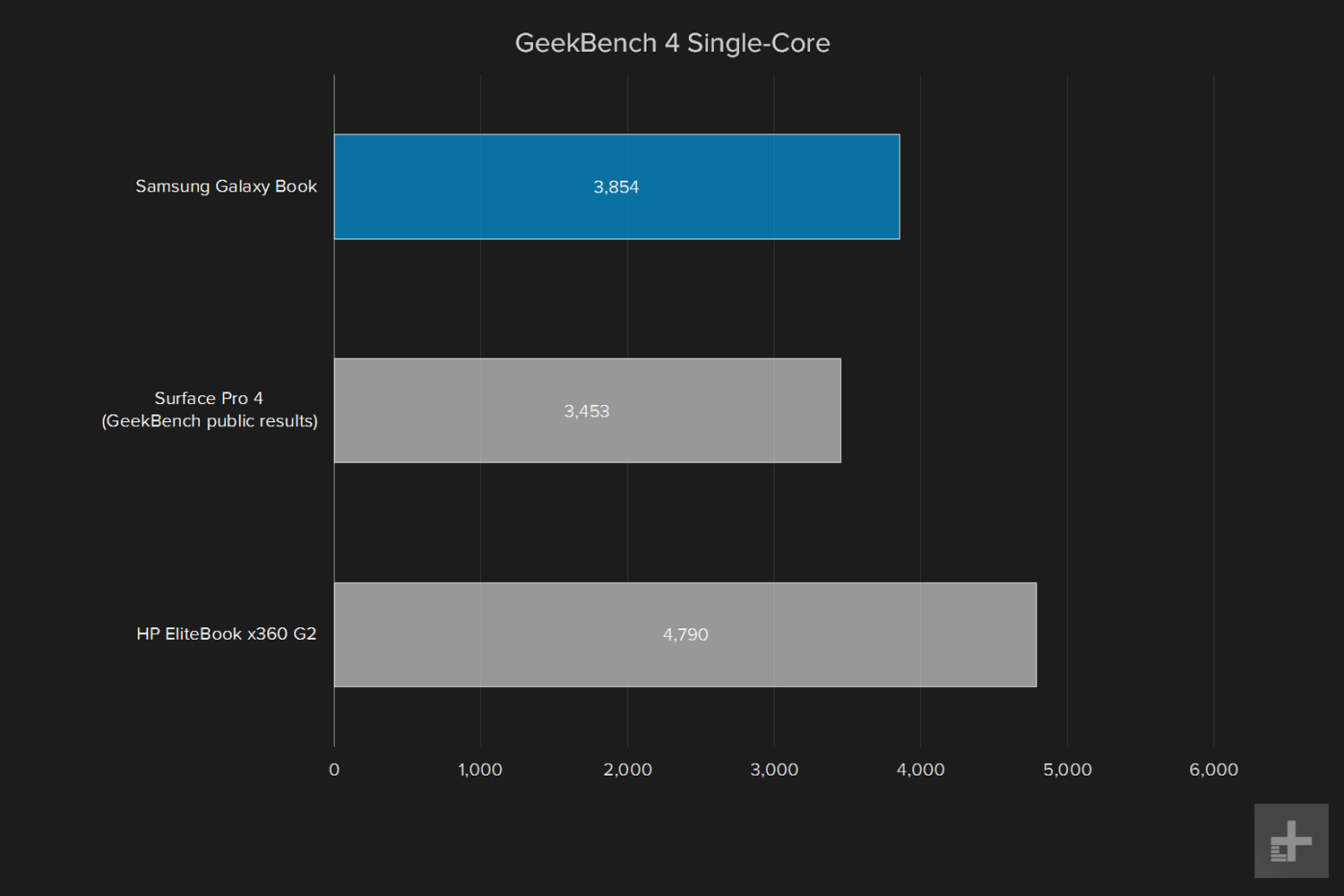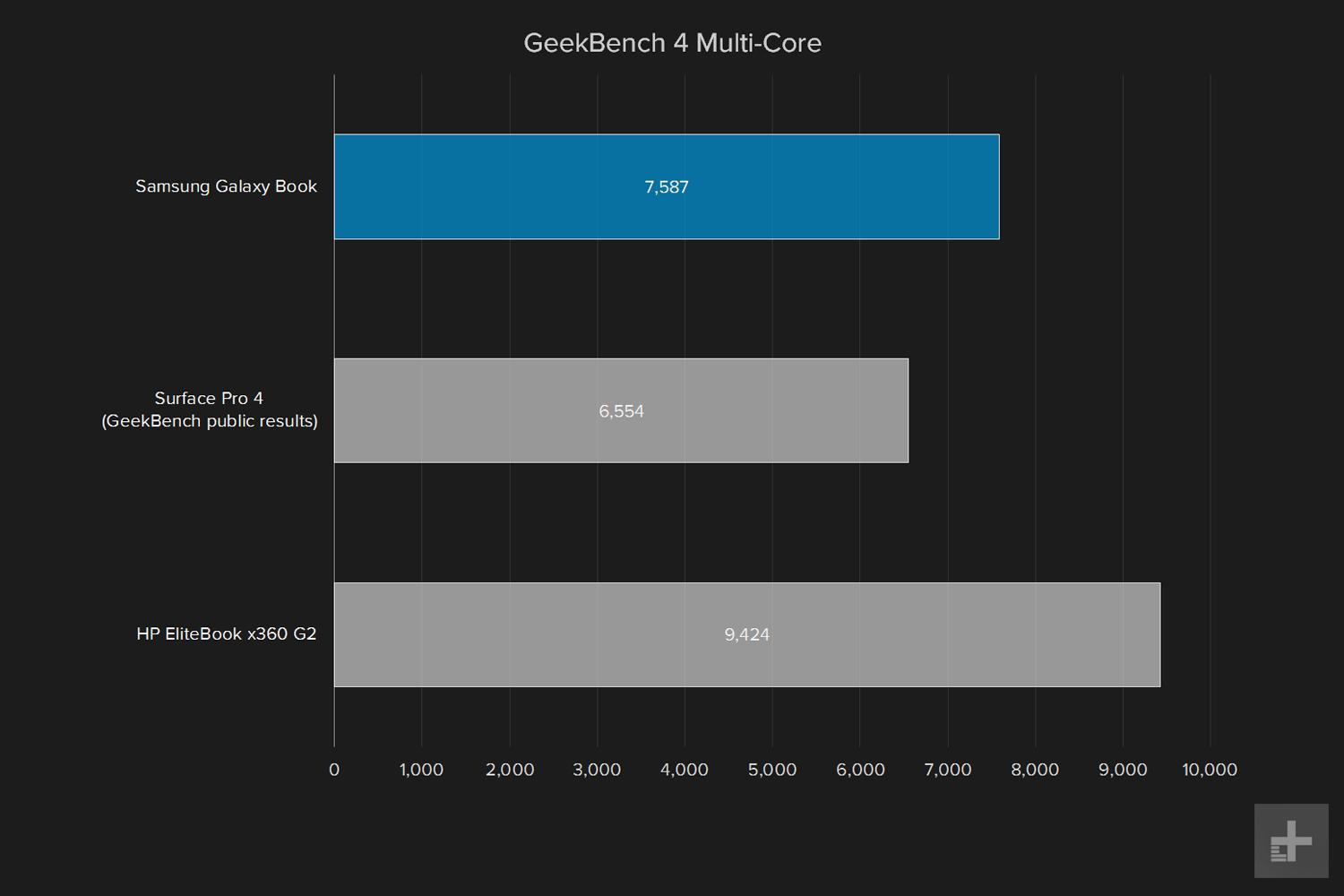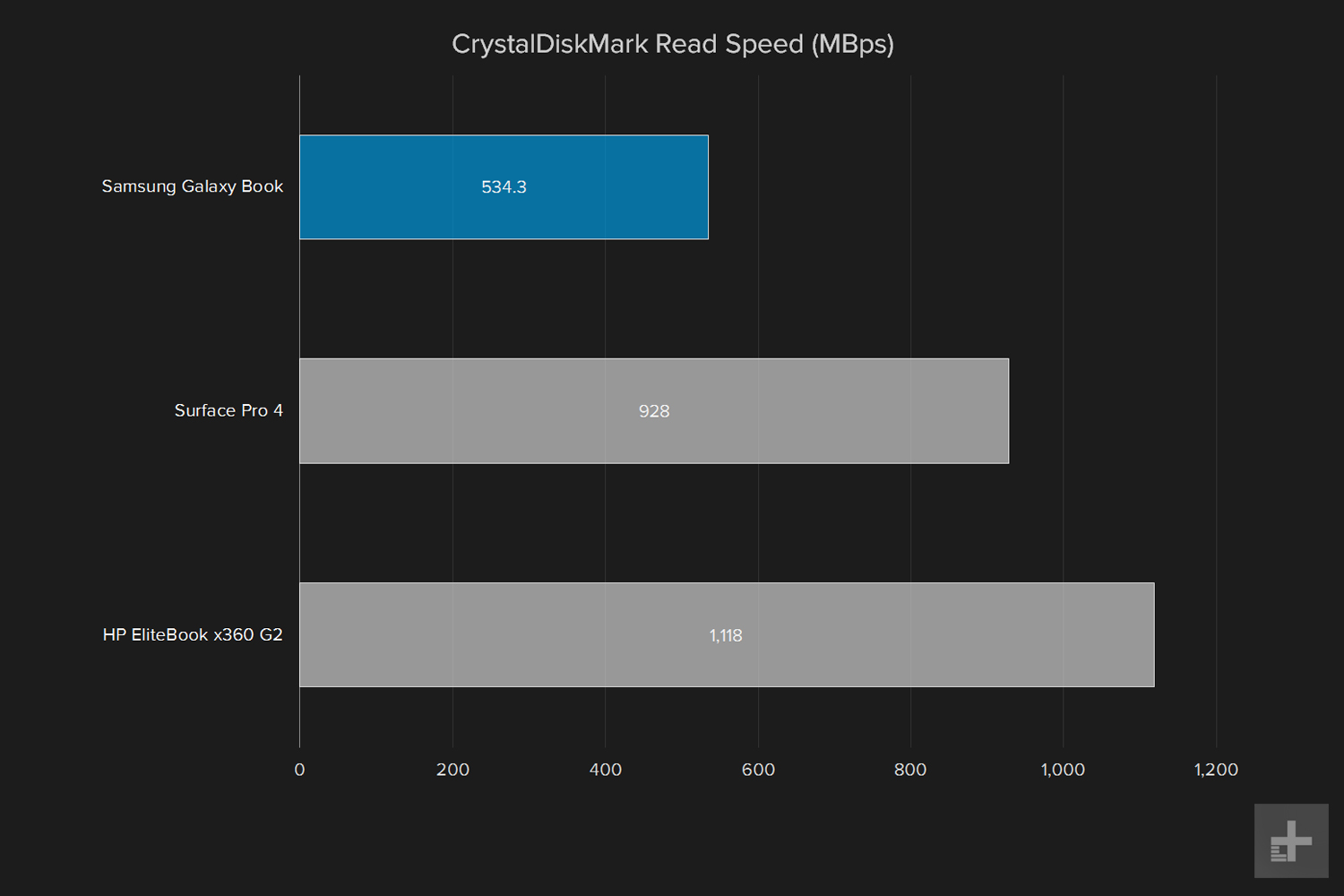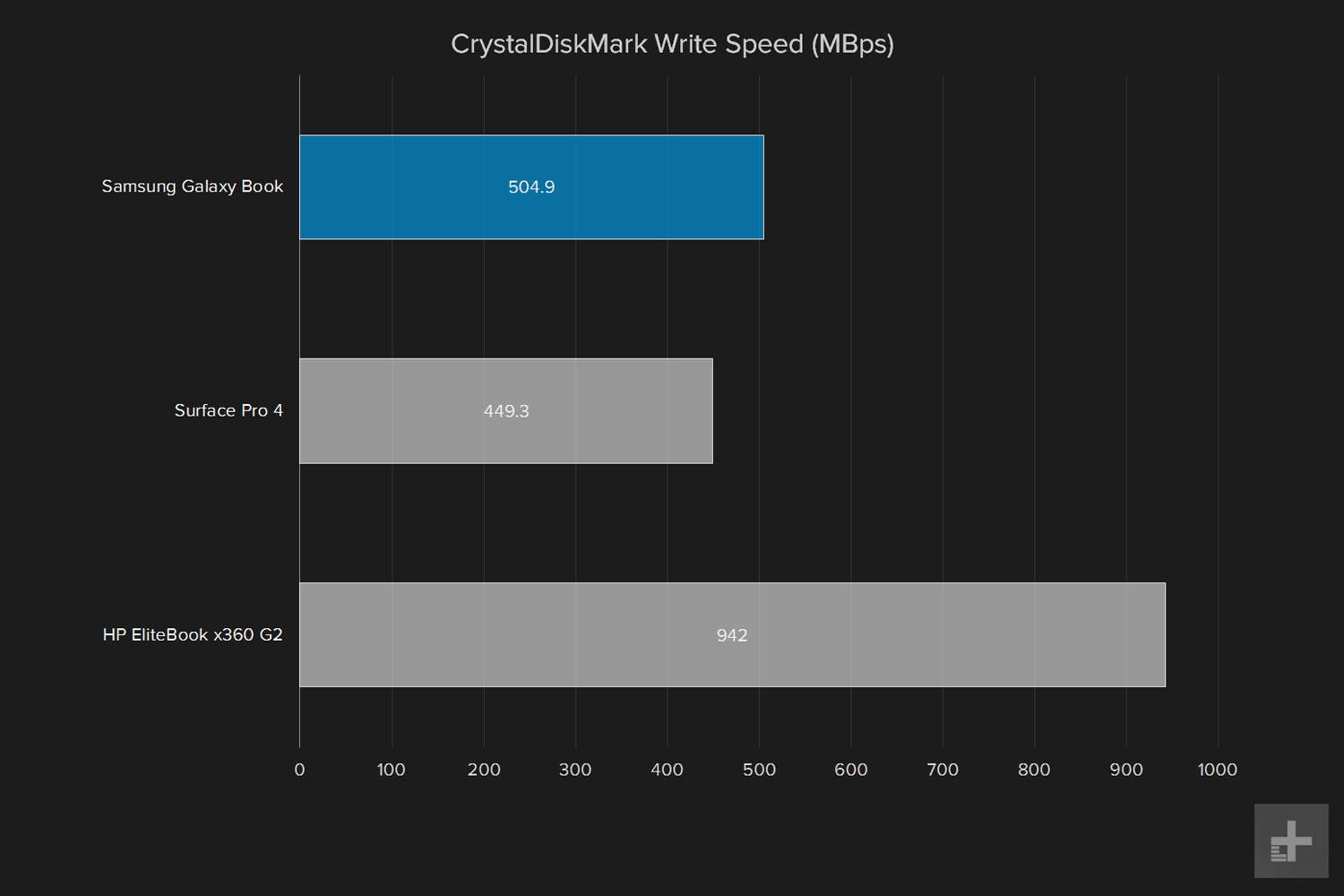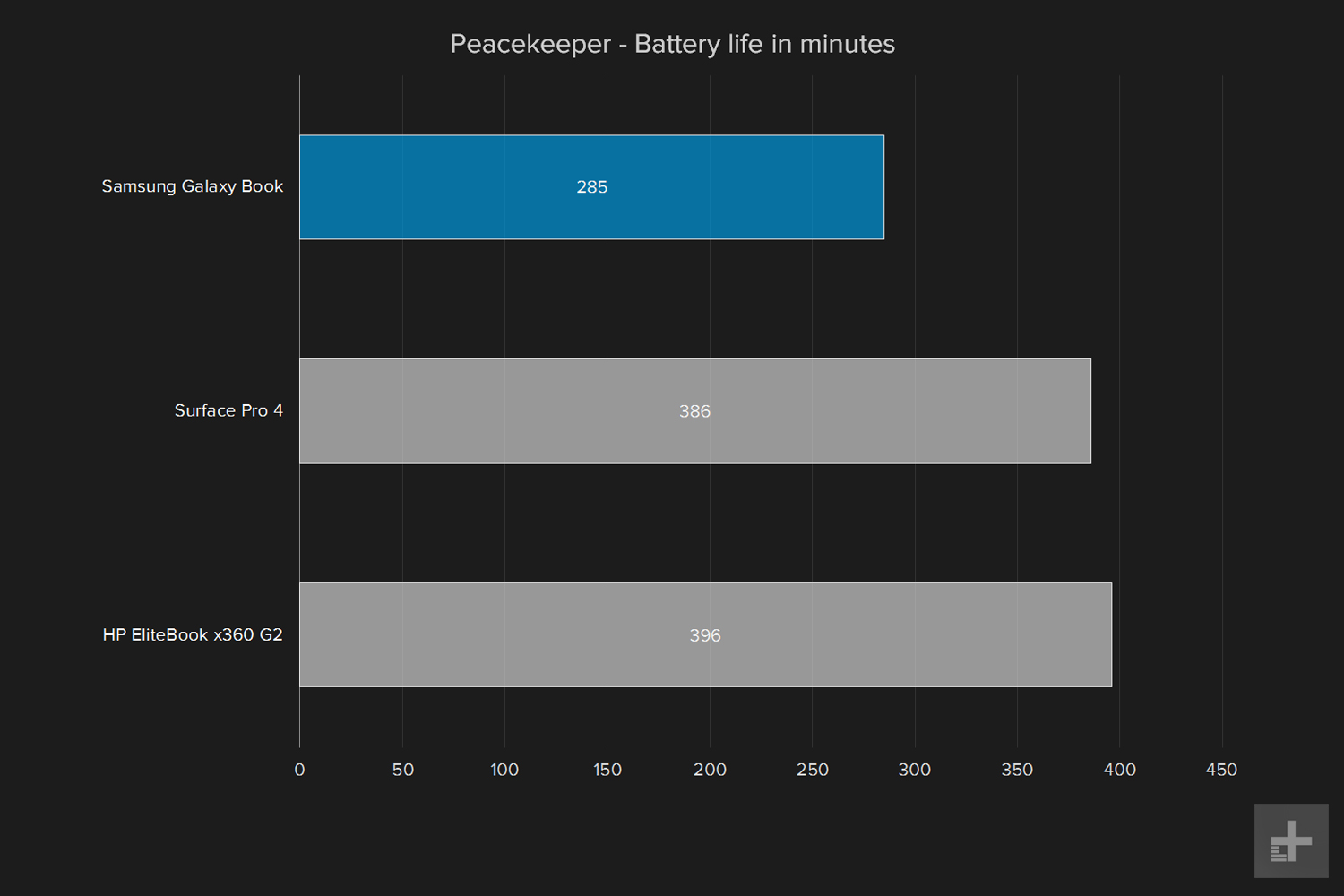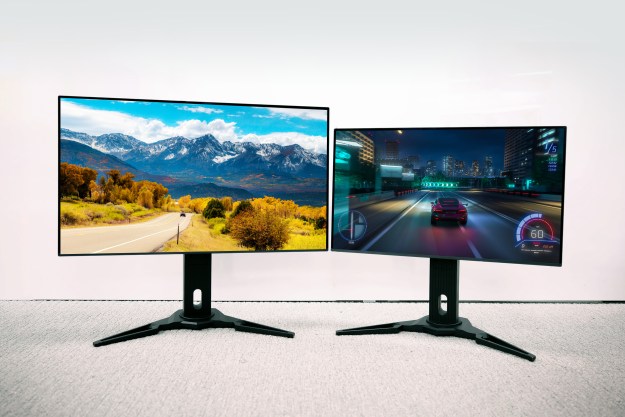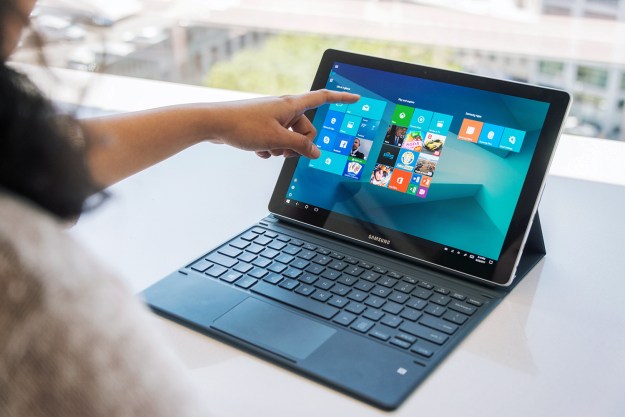
“The Galaxy Book’s display is out of this world, but its battery life and keyboard keep it grounded.”
- Thin and light
- OLED display looks beautiful
- Clear, loud speakers
- Solid processor performance
- Awkward keyboard cover
- Lacks built-in stand
- Poor battery life
Over the last few years, 2-in-1 and hybrid systems have gone from clumsy pipe-dream to something of a creative outlet for normally stodgy computer makers. It’s also given traditionally smartphone-centric brands like Samsung and LG an entry point into the computing market, by leveraging existing skills building tablets.
Samsung’s previous attempt, the TabPro S, was alright. Its awkward design didn’t sit right with laptop users, but the Super AMOLED screen looked great. Samsung’s Chromebook Pro and Plus improved on the formula, but without Windows 10, they focused on budget buyers instead of competing with the Surface Pro 4.
The Galaxy Book hits the reset button on Samsung’s 2-in-1 line, with Windows 10, two size options, Intel Core i5 processors, and an improved Super AMOLED screens that promise deep black levels and unmatched contrast. Pricing starts at $1,130 for the 12-inch version, which has 4GB of RAM and a 128GB solid state drive. Our review unit, upgraded to 8GB of
Is the Galaxy Book a new beginning for Samsung’s PC ambitions? Let’s find out.
Unbearably light
There are two distinct pieces to Samsung’s Galaxy Book: the tablet and the detachable keyboard. The tablet itself shows off Samsung’s strong points, with a design language lifted directly off its Galaxy smartphone line. It has sleek, rounded edges, and a medium-dark silver color that users may recognize from the Chromebook Plus. It’s light enough to work well as a tablet, with a texture that doesn’t slip, although the buttons on the upper left aren’t exactly convenient.
The trade-off is that the Galaxy Book is so very, very light, it doesn’t feel like a sturdy system. There’s no panel flex, and there are no major gaps to speak of, but the competing Surface Pro keeps its weight below two pounds as well, and feels a lot more premium than the Galaxy Book. The shape is also very nondescript – which will work for some people.
Both systems suffer the same issues when used as a laptop. The Galaxy Book has a folio keyboard, so it wraps around the system like a hot dog bun, with magnetic points on the cover to stick to magnetic points on the tablet. Propping up the screen means scooting the back cover down to one of several points, as opposed to the kickstand on the Surface Pro, which adjustable to any position along its range of motion. While neither system sits well on your lap, the Galaxy Book takes up gobs of space, which makes it particularly hard to use in tight quarters.
A few good ports
The Galaxy Book has a pair of USB Type-C ports and a 3.5mm headphone jack. That’s a common set of configurations for the category, and even beats out the new Surface Pro, which only boats a Type-A USB Port. The Galaxy Book charges over either of its Type-C ports, where the Surface’s magnetic power connection pops right out if someone trips on the cable. There are advantages on both sides, but the Galaxy Book certainly has the better set of wired plugs.
For wireless connections, the Galaxy Book packs in 802.11ac Wi-Fi, Bluetooth 4.2, and optional LTE.
Feeling awkward
As we mentioned above, the Galaxy Book’s detachable keyboard and touchpad don’t set the bar high for sturdiness and space.
Despite a physical connection to the system, we often saw lag in keyboard and trackpad response after the system was sitting idle for a short time. It didn’t take long, and even during our screen testing, we had issues when we didn’t touch either input for less than 30 seconds. It’s a minor inconvenience, but also one that shouldn’t exist.
The keys themselves have solid travel, with a soft, linear action that will appeal to laptop users looking for something light for occasional typing. It’s backlit as well, with three different color settings that illuminate the characters, and the keycaps around them, in a bluish off-white.
Active stylus support is the saving grace for the so-far-troubled Galaxy Book. The pen provides a sharp, responsive writing experience, although its drawings capabilities don’t quite match the sensitivity levels provided by the Surface Pen and PixelSense display.
The pen writes a familiar story. On its own it feels comfortable and light, if not on the small side. It writes well, and Samsung’s handwriting wizardry is sharp and reliable. Sitting next to the Surface Pen, the difference is evident immediately. The Surface Pen’s sturdy, barrel-shaped design feels excellent in hand, writes and draws beautifully, and has a real button and eraser, where the Galaxy Pen only has a side button.
Movie and music machine
Finally, the Galaxy Book has its moment in the sun. Samsung’s displays have always been a strong point for the brand, and it was one of the first manufacturers to put OLED displays into
No, the number isn’t a mistake — the Samsung really did hit a contrast ratio above 300,000:1, thanks to the perfect black levels provided by its Super AMOLED panel. It dunked on the Surface Pro 4, which boasted one of the best contrast ratios we’ve seen from a non-OLED screen at just over 1,000:1. The Surface Pro 4 must backlight the whole screen all the time, so even a completely black screen still has some brightness to it, where the Samsung has none.
Color accuracy was nothing to write home about, but that’s typically only important to those doing design or production work. The Samsung makes up for it by covering a whopping 99 percent of the AdobeRGB spectrum, a quality we’re only used to seeing in high-end desktop monitors and the very
The screen is a joy in everyday use.
Not only does the screen score exceptionally well in almost all our tests, it’s a joy in everyday use. Deep black levels are incredibly important when it comes to image quality and immersion, because they allow greater sense of depth, and greater detail in shadows. A simple, black jacket is the perfect example. Most
The Galaxy Book also manages to pack in some serious speakers for its size. Even at full volume, they produce loud, clear sound, with just a hint of distortion, something we’re not used to hearing from
Ready to sprint
Our review unit was powered by the Core i5-7200U with 8GB of
Compared to similar systems, the Galaxy Book holds its own performance-wise. Granted, these are all a far cry from the sort of performance we see from higher-end
In everyday use, the Galaxy Book didn’t feel sluggish or unresponsive, which becomes the more pertinent question at this end of the performance spectrum. Snappy performance and fast boot times are critical, and the Galaxy Book 12 did not disappoint.
Just an SSD
The SSD in our review unit had 256GB of capacity, which is the other half of the upgrade from the base 12-inch model. The drive connects over the usual SATA standard. Some systems are moving towards the PCIe connection, which has performance benefits.
While Samsung’s read and write speeds were competitive, both the HP EliteBook and Surface Pro 4 beat them handily, thanks to their use of the faster PCIe connection. The Surface Pro 4 is a middle ground, with faster read speeds, but write speeds that fall in line with the Galaxy Book.
Given the price, we feel giving the Galaxy Book 12 a PCIe drive would’ve been the right call. It’s ironic, actually – Samsung itself produces some of the best solid state drives, but its 2-in-1 falls behind competitors in this area.
Game off
We have yet to see a 2-in-1 with any sort of graphical power, and the Galaxy Book is no different. Its Intel HD 620 integrated GPU is fine for 2D games and HD movies, but lacks the sort of power, and driver support, needed for modern 3D titles.

The 3DMark scores of the competitors fell close to each other, but were all well short of even the most basic dedicated GPU options found in larger systems. Not that we expect anywhere near that sort of performance, particularly in smaller, portable machines like the Surface Pro and Galaxy Book.
Its benchmark performance didn’t give us confidence in the Galaxy Book’s gaming prowess, and a quick test run in Sid Meier’s Civilization VI only confirmed that. The game ran at just over 10 frames per second on average at 1080p, with 2X MSAA on, and both sliders set to medium. At Ultra, it went from moderately unplayable to a complete slideshow, at five frames per second.
It might be able to play the odd round of Hearthstone, but if your first question is “can it game?” it’s unlikely you’ll be satisfied with the answer.
Compact size, compact battery
Coming in under two pounds, the Galaxy Book is exceptionally compact. It folds up neatly, and its small footprint means it shouldn’t have any issue fitting into a small back or laptop backpack. That’s only half the story.
The other half is battery life, an area where 2-in-1s don’t just need to be average, they need to be excellent. It’s one of the main draws in a lightweight laptop, and the Galaxy Book does fine, but that’s about the nicest we can say.
It falls behind the Elitebook G2 in longevity in all but the video playback loop, where both systems lasted just over 12 hours. Both Peacekeeper and a web browsing loop drained the Galaxy Book’s battery in less than five hours, well short of the Elitebook. The Microsoft Surface Pro 4 lasted six hours, 26 minutes in the Peacekeeper test – and its hardware is several generations older. We’ve not yet tested the battery life of the new Surface Pro.
We previously hoped that OLED screens would improve battery life, but in practice, that’s only been the case in certain situations. That said, the Galaxy Book packs plenty of battery life for a mixed workload, although you may still want to bring a charger to the office.
Ditch the screensaver
Samsung has kept its Windows 10 installation clean for the most part, although there were certainly some oddities right out of the box. For one, Samsung still insists on using a screensaver, which is just the default cheesy spinning text. As Microsoft has moved almost every system setting into the new Settings pane, screensaver options were left in the old dialogue menu, so turning it off requires a few steps.
Apart from that, there’s no extra bloatware to speak of. Samsung includes a settings panel, but it rolls everything esoteric about the machine into one simple application, including screen options, keyboard and stylus options, and even customer support and warranty links. If manufacturers must include such a menu, that’s the way we prefer they do it.
Warranty
Samsung’s one-year limited warranty on the Galaxy Book is typical of the category.
Our Take
Samsung’s Galaxy Book 12 aims squarely at Microsoft’s Surface Pro and similar 2-in-1s, and it lands at least one hit – display quality. For some users, the OLED screen will be the killer feature, and admittedly, there’s a lot of appeal to a system that makes watching movies and music videos an absolute pleasure. Yet you might not watch for long, because the tablet’s battery life is a sore spot.
Is there a better alternative?
Yes. In fact, that’s the Galaxy Book’s biggest issue. It seems appealing at a glance, but loses when set next to the cheaper, more refined Surface Pro. HP’s EliteBook x360 G2 is more expensive, but has one of our favorite laptop keyboards and killer performance. There’s no shortage of competitive 2-in-1s, which means Samsung must really kill it to make a name for itself. The Galaxy Book doesn’t go far enough.
How long will it last?
Samsung’s adoption of cutting edge tech is limited to the Super AMOLED screen and active stylus support. It’s unlikely any major new features will come to the category in the next few years, and a full-power SSD also helps this system go the distance. Whether it will physically hold up is a question only time can answer, but that keyboard may need a replacement after a couple years.
Should you buy it?
No, unless the Galaxy Book will spend most its life playing movies. It’s not that the Galaxy Book is a bad option – but there are better options for a lower price.
Editors' Recommendations
- The best MacBook to buy in 2024
- Best laptop deals: Save on the Dell XPS 14, MacBook Pro 16 and more
- The MacBook Air M3 has one change that fixes its biggest flaw
- Samsung adding Auracast and 360 Audio to more TVs, phones, and earbuds
- The 4 best Samsung laptops for work and play in 2024





